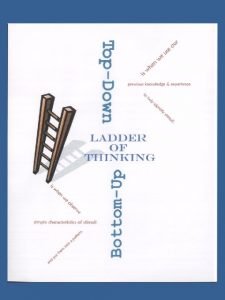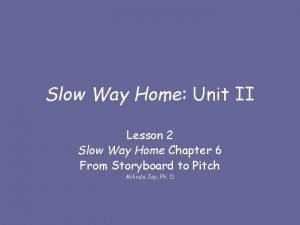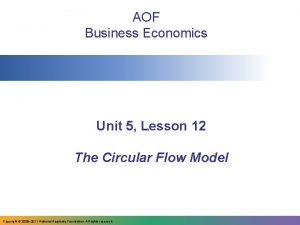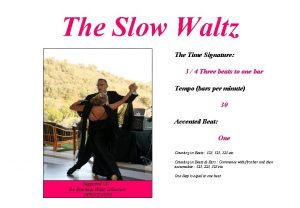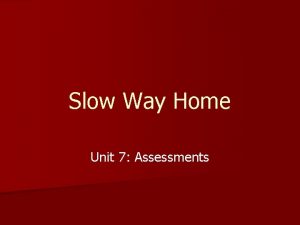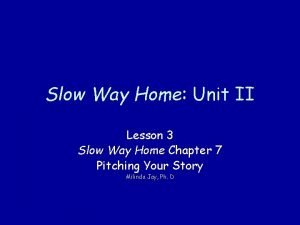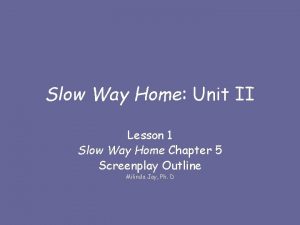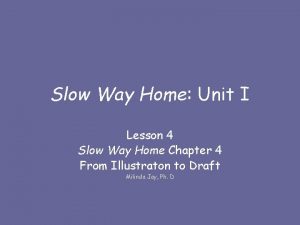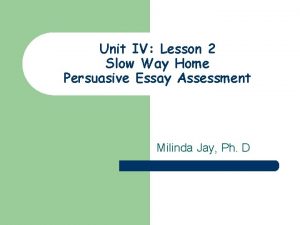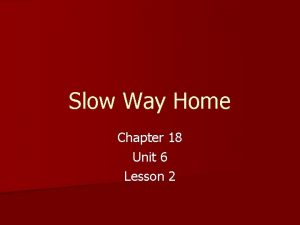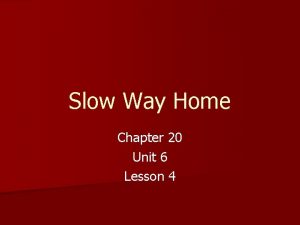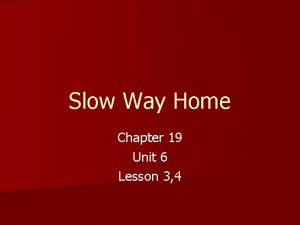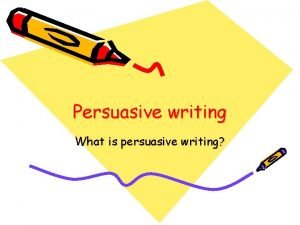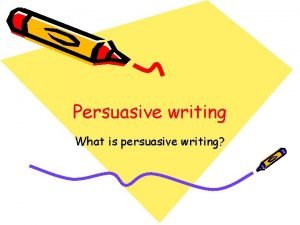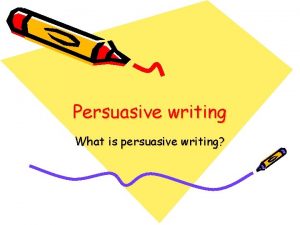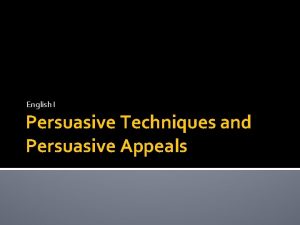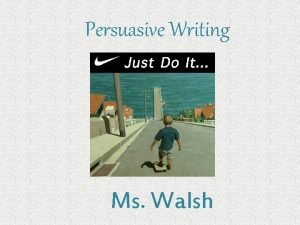Unit IV Lesson 1 Slow Way Home Persuasive



































- Slides: 35

Unit IV: Lesson 1 Slow Way Home Persuasive Writing Assessment

Sunshine State Standards l l Strand: Writing Applications Standard 3: Persuasion LA. 910. 4. 3. 1 The student will write essays that state a position or claim, present detailed evidence, examples, and reasoning to support effective arguments and emotional appeals, and acknowledge and refute opposing arguments; and LA. 910. 4. 3. 2 The student will include persuasive techniques.

l Read aloud Chapter 11 of Slow Way Home

l Convince a judge that kids should be allowed to choose with whom they live.

l Convince a judge that kids should not be allowed to choose who they live with.

l Remember: the purpose of a persuasive essay is to either change someone’s mind about something, or to get him/her to take an action, that is get him/her to do something about a situation.

l To persuade someone of something, you have to first get inside of his head and figure out what he might be thinking so that you can effectively deal with your opposition.

l If you don’t know what your audience is thinking, you need to imagine that you are writing to one person who believes in a certain way.

l For example, for this essay, a judge may have had a thirteen year old child who wanted to live with his father because his father had no rules and was rarely home, while the mother was home, had rules and loved her son.

l Or, on the opposite side, a judge may have had an 8 year old child like Brandon who loved his mother, but really needed to live with his grandparents.

l When you are writing a persuasive essay, if you can see the face of the person you are persuading, you will write a more effective essay.

Ok, so let’s do a debate style brainstorming session.

Teacher, divide the class into groups l l those who want to convince a judge they should let kids decide, and those who want to convince a judge they shouldn’t let kids decide.

Now, further divide the class l so that there are no more than six people in each group.

Organize an informal debate

Hand out Debate Note Cards (Word Document) l Give each group a chance to make note cards using the Debate Note Card Word Document.

Write three reasons your argument is a valid one l l l on three note cards, (Debate Note Cards Reason 1, 2 and 3) Include one logical reason to support your argument Include at least one good illustration or specific example with emotional appeal in support of this logical reason.

Reason=logic Illustration=emotional appeal l l The reason should appeal to the listener’s logic, but the illustration should appeal to their emotions! Personal stories about people, either people you know, have read about in a book or seen in a movie or TV show have emotional appeal.

Deal with the opposition l l l Fill out three note cards that argue against the opposition, that is three note cards in which there is an argument on each that argues against a reason that you think your opposition will give in favor of their argument. (Debate Note Cards Opposing 1, 2, 3)

Reason=logical appeal illustration=emotional appeal l Remember, once again, one logical reason, then one illustration that offers emotional support, a real story about a person, or a group of people, or a real life situation.

Organize your debate l Set up a table or desks in the front of the class for 12 people, six on each the proteam; six on the con-team.

Choose a panel of 7 judges l l From students whose group is waiting to go in the next round. These judges will take notes and decide which team offers the most convincing argument.

Each team takes turns presenting reasons l l l Pro team presents one reason in support of pro argument Con team presents one reason in support of con argument Until all three reasons from all three teams have been presented

Take notes l l As the pro group presents their evidence, con group take notes on each piece of evidence presented so that you can come up with a reason and illustration to refute their reason and illustration. As the con group presents their evidence, pro group take notes on each piece of evidence presented so that you can come up with a reason and illustration to refute their reason and illustration.

Take a break to organize your three refuting arguments l l Now, the groups take a five minute break and organize their evidence so that they can refute each of the three reasons the opposite group has given. Be certain you offer an illustration to support each refuting argument (Debate Note Cards Refutation 1, 2, 3).

Begin the Refutation l l Each group, once again, takes a turn presenting their refutations 1, 2 and 3. “in response to Jane’s evidence that…. We would like to say…. For this reason…. ”

Refutation l Each group should do this three times until each original reason presented by the opposition has been refuted.

Take notes for closing argument l as your opponents are speaking, take notes so that in your closing statements, you can walk away with a strong argument!

Take five and prepare closing arguments l l l After all have presented, take five minutes and prepare your closing statements (Debate Note Cards Closing Statement). Use your best persuasive language and strategies to convince your panel of judges that your argument is, in fact, the best one.

Present Closing Statements l Each group takes turns presenting one final closing statement.

Judges choose your winner l The panel of judges votes on which group wins the debate.

Let the debates begin!

Brainstorming complete!! l After each team has presented, students now have enough evidence to write their own essay.

Look at the rubric l l This essay will be graded based on how convincing the essay is. Does the reader feel persuaded after having read the essay?

Tomorrow l Class will spend 45 minutes of class time tomorrow writing the persuasive essay.
 Slow way home
Slow way home Slow way home
Slow way home Slow machines lesson 2
Slow machines lesson 2 Slow way home
Slow way home Twelve principles of animation
Twelve principles of animation Plurals of flower
Plurals of flower Economics unit 5 lesson 9
Economics unit 5 lesson 9 Pengertian homecare
Pengertian homecare Perbedaan home care dan home visit
Perbedaan home care dan home visit Mobile home parks for sale in sc
Mobile home parks for sale in sc Softly and tenderly jesus is calling
Softly and tenderly jesus is calling Oak springs rv park
Oak springs rv park Let's go to my house let's go today
Let's go to my house let's go today John heartfield
John heartfield She said that, home economics stands for the ideal home.
She said that, home economics stands for the ideal home. Home sweet home survival
Home sweet home survival Right triangle trigonometry
Right triangle trigonometry How to do a two way frequency table
How to do a two way frequency table Two way anova
Two way anova Threaded binary tree advantages and disadvantages
Threaded binary tree advantages and disadvantages Perbedaan anova one way and two way
Perbedaan anova one way and two way 2 way anova example
2 way anova example One way anova vs two way anova
One way anova vs two way anova Contoh soal anova two way
Contoh soal anova two way The old way and the new way
The old way and the new way Bottle of rum to fill my tum
Bottle of rum to fill my tum Walk this way talk this way
Walk this way talk this way Unit 10, unit 10 review tests, unit 10 general test
Unit 10, unit 10 review tests, unit 10 general test Process of assembling troops and supplies for war
Process of assembling troops and supplies for war Sweet home lesson
Sweet home lesson Slow carbon cycle
Slow carbon cycle Slow growth age structure diagram
Slow growth age structure diagram Time signature for waltz
Time signature for waltz Fast clock to slow clock synchronization
Fast clock to slow clock synchronization Perbedaan rapid sand filter dan slow sand filter
Perbedaan rapid sand filter dan slow sand filter Remedial teaching
Remedial teaching
